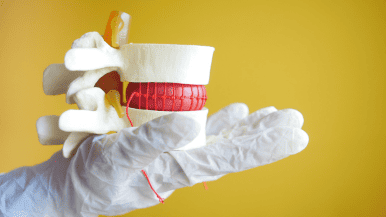 Arthritis is a group of painful and degenerative conditions marked by inflammation in the joints that causes stiffness, pain and limited movement. Osteoarthritis, the most common type of arthritis, worsens with age, and is caused by wear and tear over time. Rheumatoid arthritis, classified as an autoimmune disease, stems from the immune system attacking the joints as if they were foreign tissues.
Arthritis is a group of painful and degenerative conditions marked by inflammation in the joints that causes stiffness, pain and limited movement. Osteoarthritis, the most common type of arthritis, worsens with age, and is caused by wear and tear over time. Rheumatoid arthritis, classified as an autoimmune disease, stems from the immune system attacking the joints as if they were foreign tissues.
There are over 100 different types of arthritis. The disease is characterized by a thinning of the protective joint surface cartilage, which produces bone-on-bone friction, swelling and pain. You may have difficulty walking, getting up from a seated position, or moving around first thing in the morning. Walking up steps, bending down, opening jars, or raising your arms above your shoulders may also be challenging.
Although no cure for arthritis exists, many treatment options are available to impede the progress of the disease and alleviate symptoms. With proper treatment, many people with arthritis are able to manage their pain, stay active and lead fulfilling lives.
Natural Ways to Treat Arthritis
Anti-inflammatory medications and painkillers are typically the treatment of choice for doctors. However, some drugs cause side effects, and more patients are turning to natural methods in an attempt to relieve their symptoms. It’s essential to talk to your doctor before trying any natural remedy. Some of the more helpful treatments without using medication include:
Move and stretch frequently. Adjust your position often when you sit still and be sure to stand and walk every half hour. Do gentle exercises or stretch before going to sleep to help you feel less stiff when you wake up.
Modify your lifestyle. Losing weight and quitting smoking can help you manage arthritis symptoms, as can a diet low in saturated fat and abundant in fresh fruits and vegetables. Being overweight can increase the complications of arthritis and add to the pain. Smoking causes stress on connective tissues, which will aggravate arthritis pain.
Exercise often. Being physically active can decrease arthritis pain. Choose activities that build muscles around the joints and avoid activities that are high-impact and that create more stress on your joints such as running, jumping, or high-impact aerobics.
Physical therapy. Physical therapy can help improve range of motion and flexibility and strengthen the muscles around your joints.
Holistic approaches. Practices like yoga or meditation can help you cope with arthritis pain, and diminish stress that can make arthritis symptoms worse. Acupuncture may also help.
Treating Arthritis with Medication
An array of medications may be prescribed by your physician to help you mitigate arthritic pain associated with inflammation, joint damage and muscle strain. The medications used to treat arthritis vary depending on the type of arthritis. Common arthritis medications include:
- Over-the-counter painkillers such as acetaminophen can help lessen pain, but do not improve inflammation.
- For more-severe pain, opioids might be prescribed. Opioids act on the central nervous system to relieve pain.
- Nonsteroidal anti-inflammatory drugs (NSAIDs) decrease both pain and inflammation. Over-the-counter NSAIDs include ibuprofen and naproxen. Some types of NSAIDs are available only by prescription.
- Specific creams and ointments contain menthol or capsaicin (counterirritants), which may interfere with the transmission of pain signals when rubbed on the skin over your aching joint.
- Disease-modifying antirheumatic drugs (DMARDs) are often used to treat rheumatoid arthritis. DMARDs slow or stop your immune system from attacking your joints.
- Biologic response modifiers – these genetically engineered drugs target specific protein molecules involved in the immune response. They are generally used in combination with DMARDs.
- Corticosteroids can be taken orally or can be injected directly into the painful joint to reduce inflammation and suppress the immune system; they include prednisone and cortisone.
Surgical Options to Treat Arthritis
When nonsurgical treatments fail to relieve arthritis pain, different surgical procedures can help. The joints can be realigned, the ends of the bones can be fused, or the joint can be changed entirely.
Common surgical procedures include:
Joint alignment surgery: During joint alignment surgery, a wedge of bone is removed from under the healthy side of the bone. A surgeon then closes the wedge, and it straightens the joints.
Joint fusion: Joint fusion surgery can be performed in different ways. Bone can be taken from another part of the body and placed between the two bones being fused to create a bone graft. Implants of metal plates, screws, or wires can be used to close the joint and position the bones next to each other so that over time, they will heal and become one.
Joint replacement surgery: If joint replacement surgery is needed, the old joint will be replaced with a prosthesis, which is often made of plastic, metal, or both. A surgeon will place a patient under anesthesia, then through an incision, remove the old damaged joint and replace it with the prosthesis. After surgery, a patient will likely stay in the hospital for three to 10 days. A new joint will typically last for 10 to 15 years and can help patients feel less pain than they did before the surgery.
Recovery from the surgery varies depending on the type of procedure. Despite which surgery you have, it’s critical to begin moving your joint to promote healing and recover strength and mobility. This includes undergoing physical therapy after surgery. Physical therapy will help to strengthen the muscles around the joints to improve range of motion.
To find out if arthritis treatment at Advanced Orthopaedic Centers is right for you, call one of our offices or contact us to schedule an appointment.



